Abstract
OBJECTIVES: The combination of poor ventilation and fuel-powered ice resurfacers has resulted in elevated nitrogen dioxide (NO2) concentrations in many indoor ice skating rinks. This study examined the factors influencing concentrations and the effects of various engineering controls in ice rinks with different resurfacer fuels. METHODS: Indoor NO2 concentrations were measured in 19 enclosed ice skating rinks over 3 winters by means of passive samplers, with 1-week average measurements during the first winter pilot study and single-day working-hour measurements in the final 2 winters. Personal exposures to drivers also were assessed during the last winter. RESULTS: Rinks in which propane-fueled resurfacers were used had a daily mean indoor NO2 concentration of 206 ppb, compared with 132 ppb for gasoline-fueled and 37 ppb for electric-powered resurfacers. Engineering controls, such as increased ventilation and resurfacer tuning, reduced NO2 concentrations by 65% on average, but outcomes varied widely, and concentrations increased in subsequent months. CONCLUSIONS: Electric ice resurfacers, increased ventilation, or emission control systems are recommended to protect the health of workers and patrons, with surveillance programs proposed to track implementation and maintain an observer effect.
Full text
PDF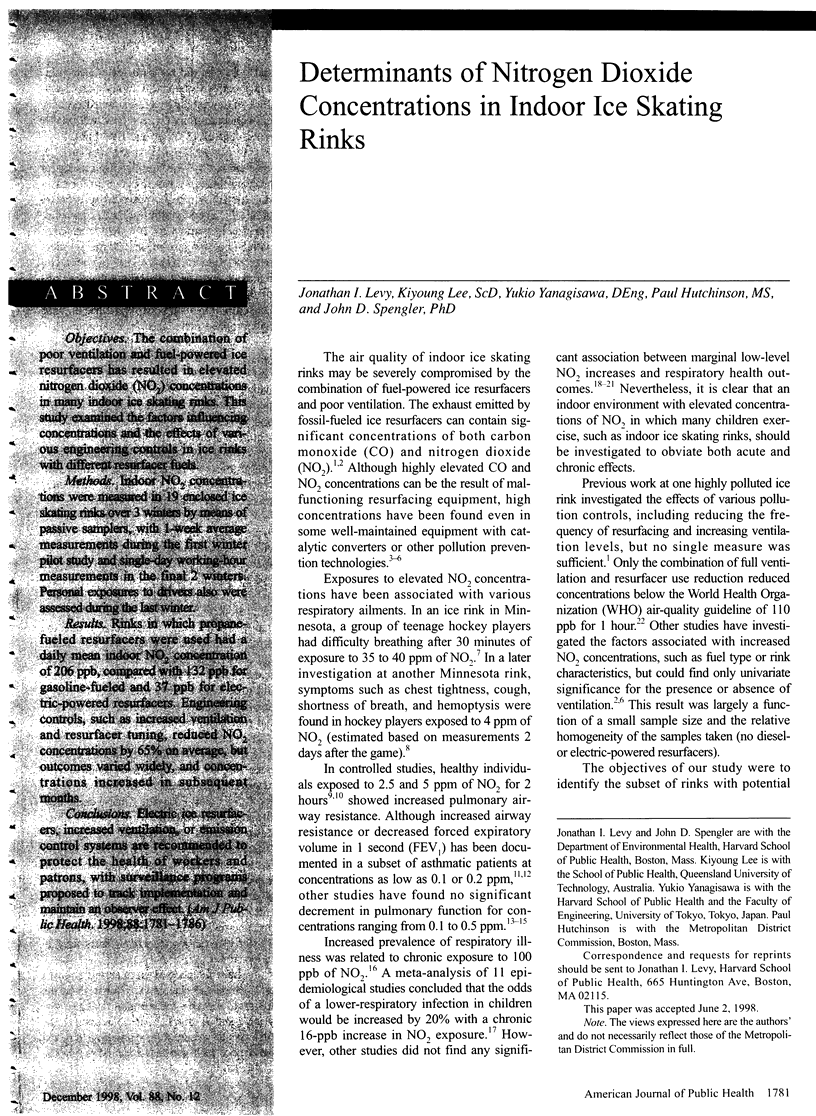
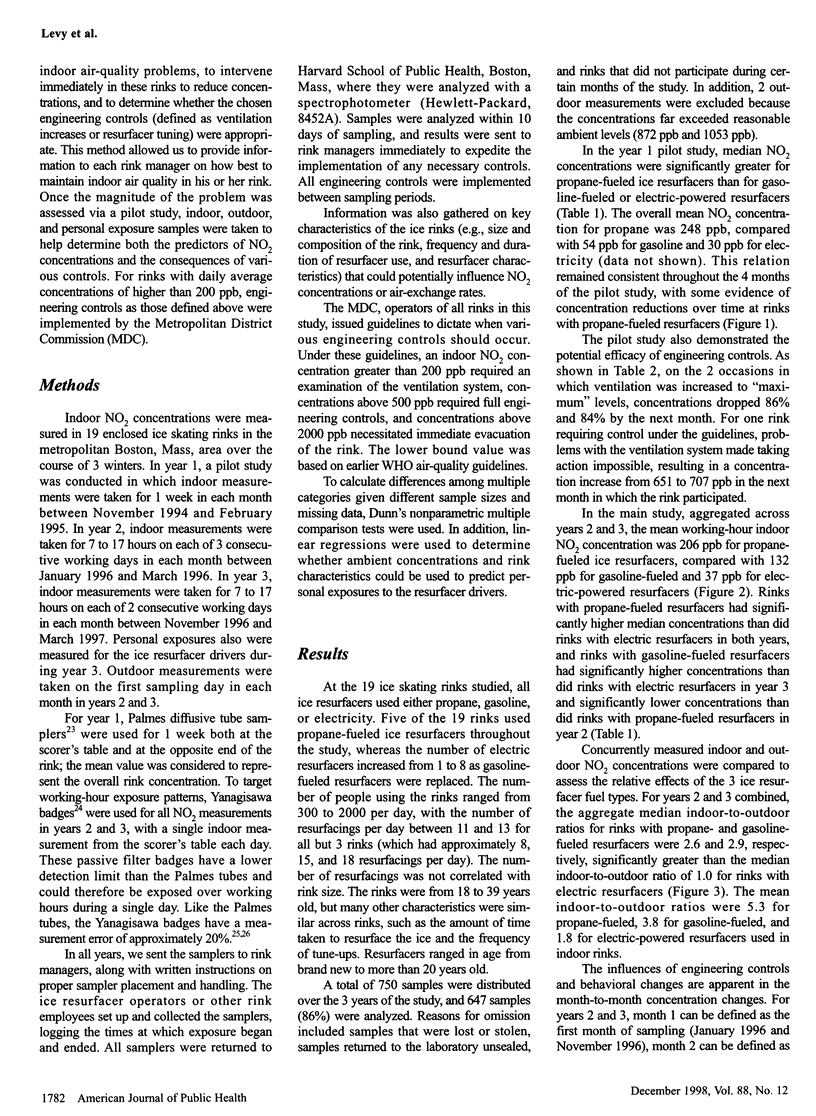
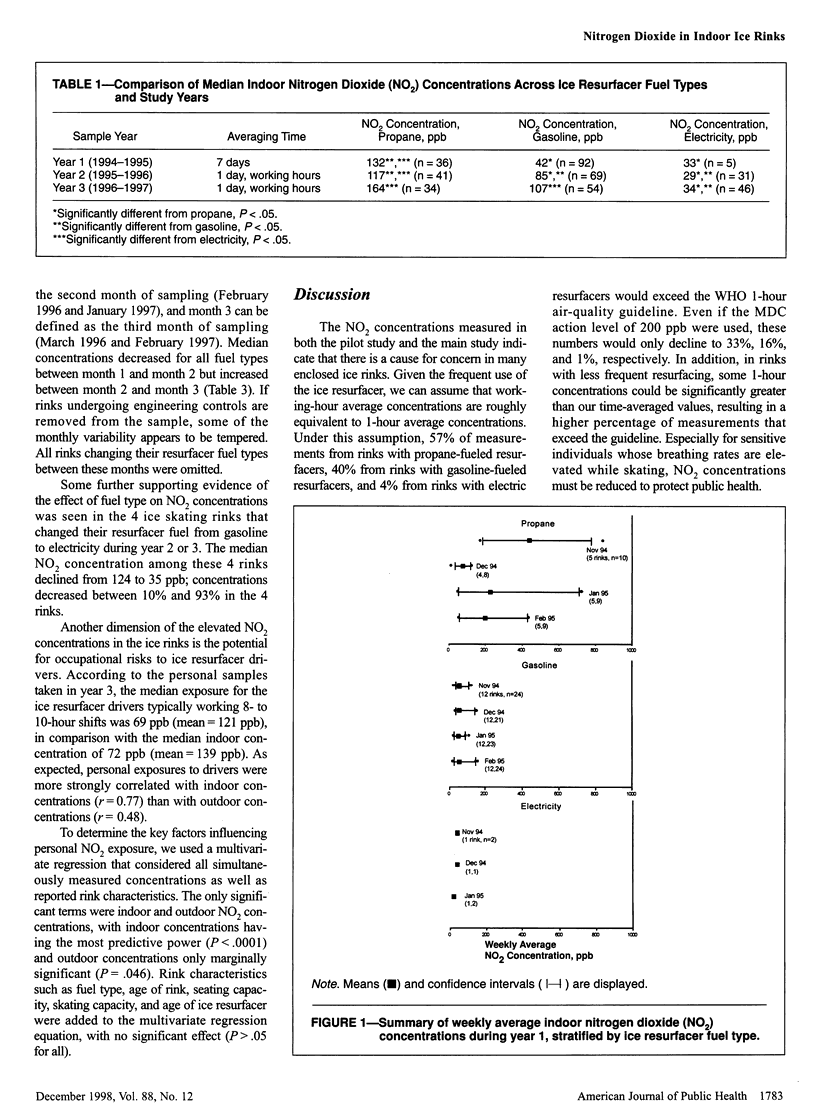
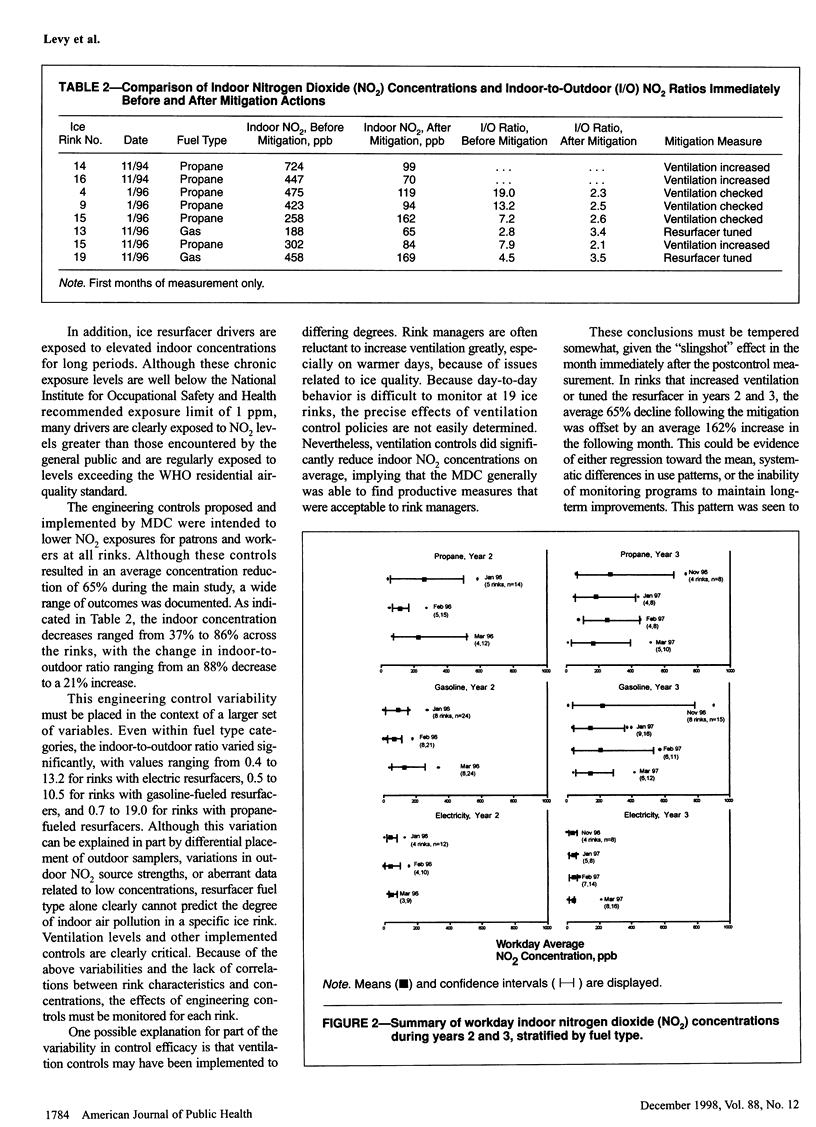
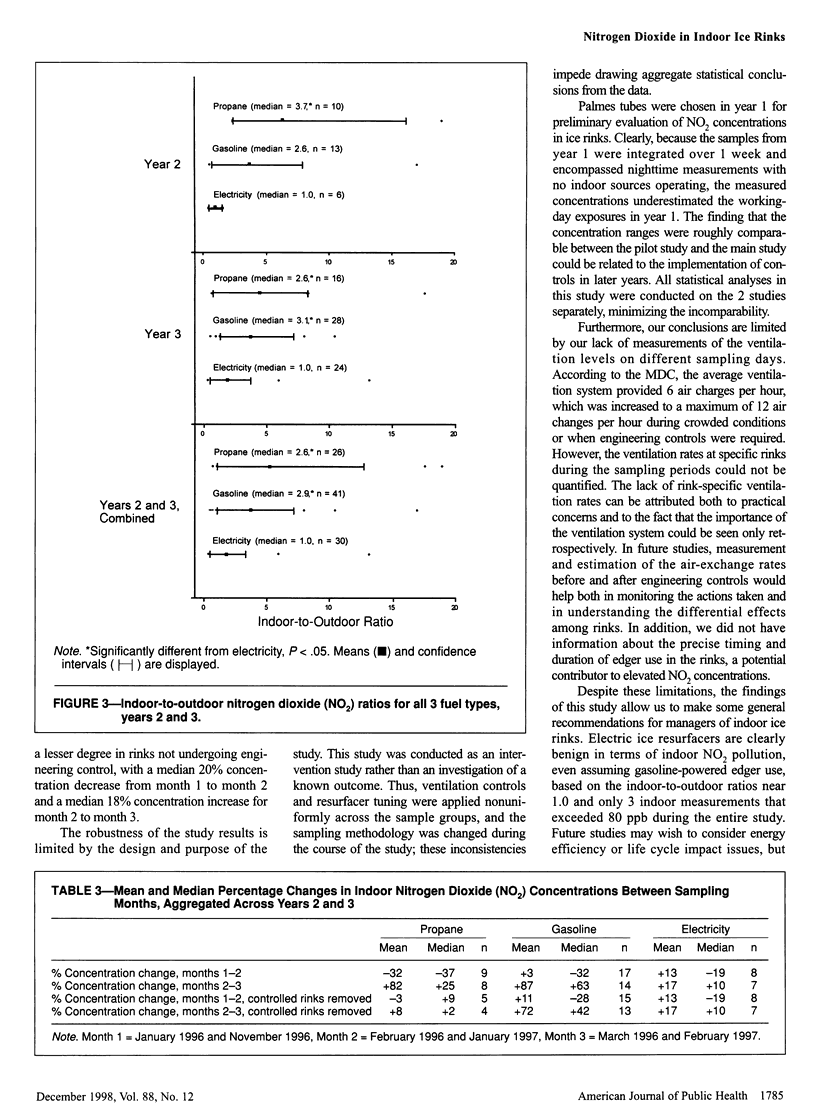
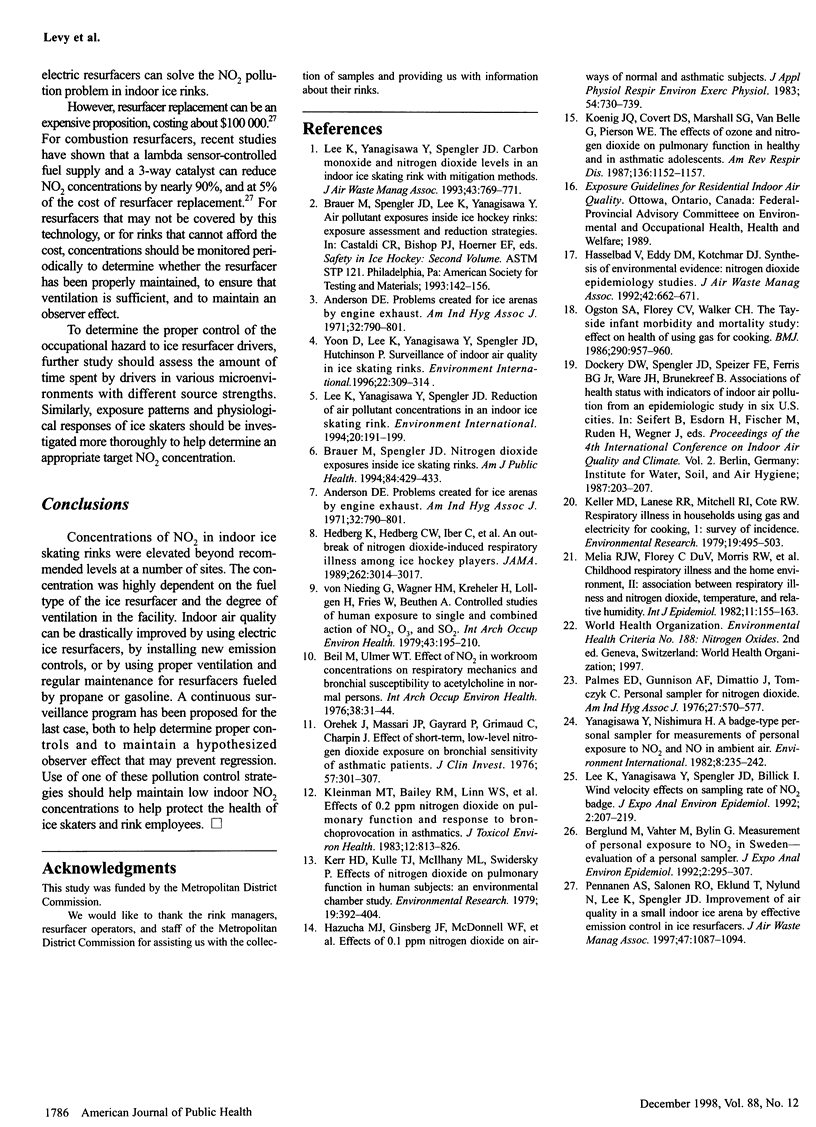
Selected References
These references are in PubMed. This may not be the complete list of references from this article.
- Anderson D. E. Problems created for ice arenas by engine exhaust. Am Ind Hyg Assoc J. 1971 Dec;32(12):790–801. doi: 10.1080/0002889718506542. [DOI] [PubMed] [Google Scholar]
- Anderson D. E. Problems created for ice arenas by engine exhaust. Am Ind Hyg Assoc J. 1971 Dec;32(12):790–801. doi: 10.1080/0002889718506542. [DOI] [PubMed] [Google Scholar]
- Beil M., Ulmer W. T. Wirkung von NO2 im MAK-Bereich auf Atemmechanik und bronchiale Acetylcholinempfindlichkeit bei Normalpersonen. Int Arch Occup Environ Health. 1976 Oct 21;38(1):31–44. doi: 10.1007/BF00378318. [DOI] [PubMed] [Google Scholar]
- Berglund M., Vahter M., Bylin G. Measurement of personal exposure to NO2 in Sweden--evaluation of a passive sampler. J Expo Anal Environ Epidemiol. 1992 Jul-Sep;2(3):295–307. [PubMed] [Google Scholar]
- Brauer M., Spengler J. D. Nitrogen dioxide exposures inside ice skating rinks. Am J Public Health. 1994 Mar;84(3):429–433. doi: 10.2105/ajph.84.3.429. [DOI] [PMC free article] [PubMed] [Google Scholar]
- Hasselblad V., Eddy D. M., Kotchmar D. J. Synthesis of environmental evidence: nitrogen dioxide epidemiology studies. J Air Waste Manage Assoc. 1992 May;42(5):662–671. doi: 10.1080/10473289.1992.10467018. [DOI] [PubMed] [Google Scholar]
- Hazucha M. J., Ginsberg J. F., McDonnell W. F., Haak E. D., Jr, Pimmel R. L., Salaam S. A., House D. E., Bromberg P. A. Effects of 0.1 ppm nitrogen dioxide on airways of normal and asthmatic subjects. J Appl Physiol Respir Environ Exerc Physiol. 1983 Mar;54(3):730–739. doi: 10.1152/jappl.1983.54.3.730. [DOI] [PubMed] [Google Scholar]
- Hedberg K., Hedberg C. W., Iber C., White K. E., Osterholm M. T., Jones D. B., Flink J. R., MacDonald K. L. An outbreak of nitrogen dioxide-induced respiratory illness among ice hockey players. JAMA. 1989 Dec 1;262(21):3014–3017. [PubMed] [Google Scholar]
- Keller M. D., Lanese R. R., Mitchell R. I., Cote R. W. Respiratory illness in households using gas and electricity for cooking. I. Survey of incidence. Environ Res. 1979 Aug;19(2):495–503. doi: 10.1016/0013-9351(79)90073-2. [DOI] [PubMed] [Google Scholar]
- Kerr H. D., Kulle T. J., McIlhany M. L., Swidersky P. Effects of nitrogen dioxide on pulmonary function in human subjects: an environmental chamber study. Environ Res. 1979 Aug;19(2):392–404. doi: 10.1016/0013-9351(79)90064-1. [DOI] [PubMed] [Google Scholar]
- Kleinman M. T., Bailey R. M., Linn W. S., Anderson K. R., Whynot J. D., Shamoo D. A., Hackney J. D. Effects of 0.2 ppm nitrogen dioxide on pulmonary function and response to bronchoprovocation in asthmatics. J Toxicol Environ Health. 1983 Oct-Dec;12(4-6):815–826. doi: 10.1080/15287398309530472. [DOI] [PubMed] [Google Scholar]
- Koenig J. Q., Covert D. S., Marshall S. G., Van Belle G., Pierson W. E. The effects of ozone and nitrogen dioxide on pulmonary function in healthy and in asthmatic adolescents. Am Rev Respir Dis. 1987 Nov;136(5):1152–1157. doi: 10.1164/ajrccm/136.5.1152. [DOI] [PubMed] [Google Scholar]
- Lee K., Yanagisawa Y., Spengler J. D., Billick I. H. Wind velocity effects on sampling rate of NO2 badge. J Expo Anal Environ Epidemiol. 1992 Apr-Jun;2(2):207–219. [PubMed] [Google Scholar]
- Melia R. J., Florey C. du V., Morris R. W., Goldstein B. D., Clark D., John H. H. Childhood respiratory illness and the home environment. I. Relations between nitrogen dioxide, temperature and relative humidity. Int J Epidemiol. 1982 Jun;11(2):155–163. doi: 10.1093/ije/11.2.155. [DOI] [PubMed] [Google Scholar]
- Ogston S. A., Florey C. D., Walker C. H. The Tayside infant morbidity and mortality study: effect on health of using gas for cooking. Br Med J (Clin Res Ed) 1985 Mar 30;290(6473):957–960. doi: 10.1136/bmj.290.6473.957. [DOI] [PMC free article] [PubMed] [Google Scholar]
- Orehek J., Massari J. P., Gayrard P., Grimaud C., Charpin J. Effect of short-term, low-level nitrogen dioxide exposure on bronchial sensitivity of asthmatic patients. J Clin Invest. 1976 Feb;57(2):301–307. doi: 10.1172/JCI108281. [DOI] [PMC free article] [PubMed] [Google Scholar]
- Palmes E. D., Gunnison A. F., DiMattio J., Tomczyk C. Personal sampler for nitrogen dioxide. Am Ind Hyg Assoc J. 1976 Oct;37(10):570–577. doi: 10.1080/0002889768507522. [DOI] [PubMed] [Google Scholar]
- von Nieding G., Wagner H. M., Krekeler H., Löllgen H., Fries W., Beuthan A. Controlled studies of human exposure to single and combined action of NO2, O3, and SO2. Int Arch Occup Environ Health. 1979 Jun 15;43(3):195–210. doi: 10.1007/BF00381191. [DOI] [PubMed] [Google Scholar]


